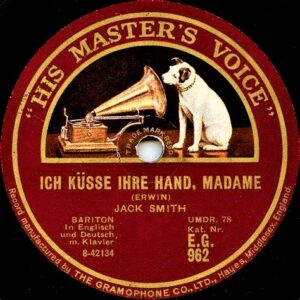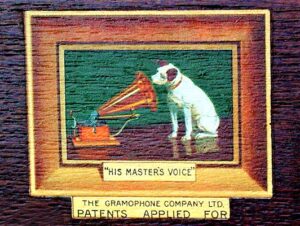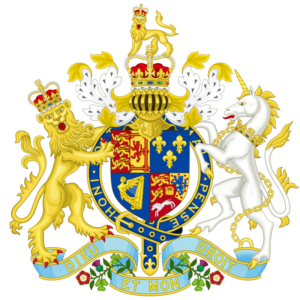His Master’s Voice, His Master’s Eyes, and His Master’s Ears
IN FOCUS, 6 Sep 2021
Prof. Hoosen Vawda – TRANSCEND Media Service
The Colonial Legacy of the Controlling Master Perpetuates in the 21st Century
2 Sep 2021 – A friend of the author from South Africa visited New Zealand[1] and had to open a bank account. He was directed to the CBD of Auckland and noted all the banks[2], trying to decide in which bank he should open an account. The man walked up and down, several times, across the entrances to the banks, almost fitting the profile of a bank robber, as if he was surveilling the banks and contemplating on which one would be the easiest bank to rob. He looked at each banks’ logo, proudly displayed in huge signage outside the bank and finally decided in which bank, he should open an account. When asked what made him decide to open an account in that specific bank, his response was immediate and stated that it was the logo of that particular bank which was the decisive factor in trusting his money to that financial institute.
Logos are historically extremely important in deciding the financial success of a company or institute and these symbols originated from the official seals of kings, emperors and royalty of a bygone era. Initially the royalty had elaborate and intricately designate crests, as evidenced by the British Royal Crest[3]. These crests were solely reserved for the rich and privileged ruling class, including the religious institutes such as the papacy, with His Holiness having an extremely special “Papal Seal”[4]. This was the certification of any documents issued from the papacy and was regarded as the original. An instrument or document of the Catholic Church or royalty is called a papal bull. Originally, it was a circular plate or boss of metal. In the Middle Ages, it came to be a leaden seal which authenticated important writings, papers, and charters. After the 13th century, the name bull was a popular term for most papal documents. The Papal Seal’s design elements also signify the importance of His Holiness on earth and Heavens. There is also a special Seal of the Vatican Secret Archives[5]. Some of these crests and seals were adapted by the countries such as Saudi Arabia, into their national flag with an excerpt from the Islamic scriptures[6]. The plebeians were excluded from having a logo or crests, based on their illiteracy and no significance in society.
Eventually, as social evolution[7] coupled with Industrial Revolution[8] progressed, and small companies developed, the need arose for these commercial houses to have a symbol of identity in the business world and the concept of a personalized logo emerged. Subsequently, marketing and advertising houses emerged to cater for the individual needs. Companies and individuals in every commercial field from motor vehicles to cinematography, to individual movie franchises such as the 007,[9] highly valued, gun barrel logo seen on the widescreen at the beginning of every one of the 24 official James Bond movies, produced by Eon Productions[10]. These logos are highly copyrighted, and any infringements by competitors is literally, legally lethal for the copyright violator. Some logos are such carefully registered that the even the shape of the emblems, text and design are specified spectroscopically and registered in terms of the exact shade of colour used to prevalent any infringements. This is readily evident in the internationally famous, McDonald fast foods, famous Golden Arch logo.[11] The Golden Arches are the symbol of McDonald’s. Originally, real arches were part of the restaurant design. They were incorporated into the chain’s logo in 1962, which resembled a stylized restaurant, and in the current Golden Arches logo, introduced 1968, resembling an “M” for “McDonald’s”.
While most consumers and the public use the logo to identify the company which produces the item, perhaps for quality or appeal, costing or legacy value, little do they realise that there may be a covert message in the design elements of the logo itself that is subconsciously conveyed to the public. Examine the Apple logo[12] with a piece bitten off, without the dental marks of a bite Has anyone thought of a deeper significance of a bitten off apple being used, rather than a full apple in the design of this logo?
It is also to be noted the era in history when the logo first appeared. This is relevant with regards to the Nazi Swastika[13], which was formulated by Hitler in glorious red colour, signifying Aryan purity[14], pride of the Aryan race, although there are no more pure Aryans and perhaps the Jats[15] come closest, based on DNA testing[16], the might and power, as well as terror displayed to non-conformists and anyone who was considered inferior. Hitler’s racial purity doctrine was responsible for the genocidal holocaust in which over six million people of Jewish origins were exterminated together with gypsies, Roamers and Russian prisoners of war in Auschwitz[17] and Bergen-Belsen[18], main concentration camps, amongst others. The swastika symbol, 卐 (right-facing or clockwise) or 卍 (left-facing, counterclockwise, or sauwastika), is an ancient religious icon in the cultures of Eurasia. It is used as a symbol of divinity and spirituality in Indian religions, including Hinduism, Buddhism and Jainism.[19]
In the Western world, it was a symbol of auspiciousness and good luck until the 1930s[20] when the right-facing tilted form became a feature of Nazi symbolism as an emblem of the Aryan race. As a result of World War II and the Holocaust, many people in the West still strongly associate it with Nazism[21] and antisemitism.[22] The swastika continues to be used as a symbol of good luck and prosperity in Hindu, Buddhist and Jain countries such as Nepal, India, Mongolia, Sri Lanka, China and Japan. It is also commonly used in Hindu marriage ceremonies.[23]
One such logo which needs to be analysed for a subtle and often hidden message, almost a warning, which is not evident at all when the logo is looked at initially, is the age old “His Master’s Voice” emblem. Recently, this logo wording, without the famous graphic, has been copied, in a slightly modified form as, “His Master Voice”, by Himabrata Das. It is the new Advance Online Publication of the Open Journal of Psychiatry & Allied Sciences (OJPAS®).[24]
It important to know the history of the “His Master’s Voice” logo and the period when it was released, to fully comprehend the covert message behind the design of this century old and iconic, easily recognizable emblem. It was used for personal musical entertainment, on long playing, Bakelite musical records, containing music from the east to the west and every type of music, in between, for worldwide distribution in the 20th century.
His Master’s Voice (HMV) was the name of a major British record label created in 1901 by The Gramophone Co. Ltd.[25] The phrase was first coined in the late 1890s as the title of a painting depicting a terrier-mix dog named Nipper listening to a wind-up disc gramophone. In the original 1898 painting, the dog is listening to a cylinder phonograph. It was a famous trademark and logo of the RCA Victor record label.
In the 1970s, the statue of the dog and gramophone, His Master’s Voice, were cloaked in bronze and was awarded by the record company (EMI) to artists or music producers or composers as a music award and often only after selling more than 100,000 recordings. The trademark image comes from a painting by English artist Francis Barraud and titled His Master’s Voice. It was acquired from the artist in 1899 by the newly formed Gramophone Company and adopted as a trademark by the Gramophone Company’s United States affiliate, the Victor Talking Machine Company.[26] According to contemporary Gramophone Company publicity material, the dog, a terrier named Nipper, had originally belonged to Barraud’s brother, Mark. When Mark Barraud died, Francis inherited Nipper, along with a cylinder phonograph and recordings of Mark’s voice. Francis noted the peculiar interest that the dog took in the recorded voice of his late master emanating from the horn and conceived the idea of committing the scene to canvas. The incident took place at 92 Bold Street, Liverpool.
In early 1899, Francis Barraud applied for copyright of the original painting using the descriptive working title Dog looking at and listening to a Phonograph. He was unable to sell the work to any cylinder phonograph company, but William Barry Owen, the American founder of the Gramophone Company in England, offered to purchase the painting under the condition that Barraud modify it to show one of their disc machines. Barraud complied and the image was first used on the company’s catalogue from December 1899. As the trademark gained in popularity, several additional copies were subsequently commissioned from the artist for various corporate purposes.[27]Emile Berliner, the inventor of the Gramophone, had seen the picture in London and took out a United States copyright on it in July 1900. The painting was adopted as a trademark by Berliner’s business partner, Eldridge R. Johnson of the recently formed Consolidated Talking Machine Company, which was reorganized as the Victor Talking Machine Company in 1901.
Johnson first used the dog-and-gramophone image in print advertisements for Consolidated in the autumn of 1900. Beginning in February 1902, most Victor records had a simplified drawing of the image on their labels. The Victor Company used the trademark far more ubiquitously than its UK affiliate, placing it on virtually all Victor products. Newspaper and magazine advertisements urged buyers to “look for the dog.” Victor erected a fifty feet square illuminated advertising sign of Nipper at Broadway and 37th Street, near the Metropolitan Opera House in New York City. In 1915, Victor installed stained glass windows depicting the logo in the tower of Building 17 of its manufacturing complex and headquarters in Camden, New Jersey; the building and windows remain today, and have long been an iconic symbol of both RCA Victor and of Camden’s industrial heritage.
In British Commonwealth countries, the Gramophone Company did not use the dog on its record labels until 1909. The following year the Gramophone Company replaced the Recording Angel trademark in the upper half of the record labels with the Nipper logo.
The company was not formally called HMV or His Master’s Voice, but rapidly became identified by that phrase due to its prominence on the record labels. Records issued by the company before February 1908 were generally referred to by record collectors as “G&Ts”, while those after that date are usually called “HMV” records. During World War I, the Gramophone Company’s German branch, Deutsche Grammophon Gesellschaft, severed ties with the British parent company and operated independently; DG retained the Nipper trademark for use in Germany until 1949, when the rights were sold to Electrola[28], which replaced DG as the EMI affiliate in Germany. The image continued to be used as a trademark by Victor in the US, Canada, and Latin America. In British Commonwealth countries (excluding Canada, where Victor held the rights) it was used by various subsidiaries of the Gramophone Company, which ultimately became part of EMI.
In 1921, the Gramophone Company opened the first HMV shop in London. In 1929, the Radio Corporation of America purchased the Victor Talking Machine Company and with it a major shareholding in the Gramophone Company, of which Victor had owned 51% since 1920. RCA was instrumental in the creation of EMI in 1931, which continued to control the His Master’s Voice name and image in the UK. In 1935, RCA Victor sold its stake in EMI but continued to own the rights to His Master’s Voice in the Americas. HMV continued to distribute Victor recordings in the UK and elsewhere until 1957, after EMI purchased Capitol Records as their distributor in the western hemisphere. The hostilities between Japan and the US during World War II led RCA Victor’s Japanese subsidiary, the Victor Company of Japan (JVC), to secede from the American parent company and become independent. Today, JVC Kenwood retains the “Victor” brand name and Nipper trademark for use in Japan only.[4] In 1968, RCA introduced a modern logo and retired the Nipper trademark, removing it from virtually all RCA advertising and products with the exception of Red Seal album covers. In 1976, largely due to public demand, RCA revived the trademark and reinstated Nipper to most RCA record labels in the Western Hemisphere. Throughout the late 1970s and 1980s, Nipper was once again widely used in RCA advertising, and the trademark reappeared for a time on RCA television sets and the ill-fated RCA CED videodisc system. In 1967, EMI converted the HMV label into an exclusive classical music label and dropped its POP series of popular music. HMV’s POP series artists’ roster was moved to Columbia Graphophone and Parlophone and licensed American POP record deals to Stateside Records.[29]
The globalised market for the compact disc resulted in EMI abandoning the HMV label in favour of “EMI Classics”, a name that could be used worldwide; however, between 1988 and 1992 Morrissey’s recordings were issued on the HMV label. The HMV/Nipper trademark is now owned by the retail chain in the UK. The formal trademark transfer from EMI took place in 2003.[30] The old HMV classical music catalogue is now controlled by the Warner Classics unit of Warner Music Group.[31] Most reissues of HMV pop material that EMI previously controlled are now reissued on Warner’s Parlophone[32] label.[33] In the UK, Warner Classics’s online presence was launched as ‘Dog and Trumpet’ on Spotify, Facebook, Twitter and Instagram in January 2017.[34]
The dog-and-gramophone image is now licensed by RCA Records and its parent company, Sony Music Entertainment, from Technicolor SA, which operates RCA’s consumer electronics division (still promoted by Nipper the dog). Thomson SA acquired the division from General Electric after GE absorbed the RCA Corporation in 1986.[35] The image of “His Master’s Voice” exists in the U.S. as a trademark only on radios and radios combined with phonographs; the trademark is owned by RCA Trademark Management SA, a subsidiary of Technicolor.[36]
With that exception, the “His Master’s Voice” dog-and-gramophone image is in the public domain in the U.S., its trademark registrations having expired in 1989 (for sound recordings and phonograph cabinets), 1992 (television sets, television-radio combination sets), and 1994 (sound recording and reproducing machines, needles, and records). EMI continued to expand internationally through the 1990s. The name HMV is still used by the chain of entertainment shops founded by the Gramophone Company in the UK and, until 2017, in Canada.
In 1998 HMV Media was created as a separate company, leaving EMI with a 43% stake. The firm bought the Waterstones chain of bookshops and merged them with Dillons the UK booksellers. In 2002 it floated on the London Stock Exchange as HMV Group plc, leaving EMI with only a token holding. HMV shops in Australia, Ireland, and the UK also use the Nipper trademark. HMV applied for trademark status in order to use Nipper at HMV stores in Canada but in 2010 abandoned the application,[37] presumably because the rights to Nipper in Canada are part of the RCA brand portfolio now owned by Technicolor SA and licensed to other companies. As of August 2006, there were over 400 HMV stores worldwide.[38] The website is operated by HMV Guernsey.
On 15 January 2013, HMV Group plc entered receivership; stores in Ireland closed 16 January 2013 and were no longer accepting vouchers. The HMV website posted a receivership notice and no further online sales were made.[39] According to the HMV website, the organisation was restructured by Hilco[40] and, while some stores were closed, it has reopened debt-free and continues to trade. As of 28th December 2018, HMV has confirmed that it has called in KPMG as administrators and entered administration for the second time in six years.[41]
On 5th February 2019, the Canadian retailer Sunrise Records announced its acquisition of HMV Retail for an undisclosed amount (later reported to be £883,000).[42] Sunrise planned to maintain the HMV chain and five Fopp stores[43], but immediately closed 27 locations.[44] By late-February, HMV had reopened several stores (including 1 Fopp branch).[45] The author has communicated with Sunrise Records[46], by website e-mails, for further information, but regrettably no response was received, even after three e-mails and a month later.
As noted, the key elements in the logo, are Nipper, the dog, lending a ear to the horn of the gramophone and listening to his Master, who is not there, but Nipper is still attentive, albeit doing so, remotely. The emblem was used by the British in the early 20th century when colonisation was the main thrust of the British foreign policy. The logo was used on all records distributed in the British colonies from Africa to the Indian peninsula and the east.
The Bottom Line is the hidden message in the emblem, which is that the residents of the colonies, occupied by the British, must listen to and obey the Master, who is the powerful and formidable British Empire[47]. The domesticated dog, Nipper, represents the subjugated citizens of the British colonies. This was particularly relevant in India, where the film industry was prolific and all the songs in these Indian movies were made available on EMI products prominently displaying the His Master’s Voice logo. These long-playing, known as LPs’, records, with the voices of famous playback singers, such as Lata Mangeshkar[48],Mohammed Rafi[49] and others[50], at the time in India, where the British Raj was the “Supreme Master”, who was far away, but omnipresent. The message was clear to the oppressed citizens, worldwide; “obey and listen to your master, who is far away in Britain”, reminding the citizens that they must follow the instructions of the master like a dog, even while entertaining themselves, in distant countries.
In the 21st century, the focus has paradoxically shifted, whereby the “Master” now has “Eyes and Ears” with the citizens of the original colonies now observing the Empire using Pegasus Spyware[51] and associated technology, including high resolution, facial recognition software. Apple phones[52] are even monitoring mobile devices containing downloaded photographs. “His Master” does not use “His Voice”, anymore, but now uses “His Ears and Eyes” with remote monitoring of the citizenry, globally. The technology used has become highly refined and intrusive, disregarding all moral and ethical codes of conduct, violating personal privacy, justifiably, on the pretext of maintaining cyber security and counteracting the existential threat of global terrorism.[53]
References:
[1] https://www.planetware.com/tourist-attractions/new-zealand-nz.htm#:~:text=12%20Top-Rated%20Tourist%20Attractions%20in%20New%20Zealand%201,one%20of%20the%20country%27s%20…%20More%20items…%20
[2] https://en.wikipedia.org/wiki/List_of_banks_in_New_Zealand#:~:text=List%20of%20Banks%20%20%20%20Country%20%2F,%20%20Westpac%20%2011%20more%20rows%20
[3] https://en.wikipedia.org/wiki/Royal_coat_of_arms_of_Great_Britain
[4] https://en.wikipedia.org/wiki/Papal_seal
[5] https://www.bing.com/images/search?q=Seal+of+the+Vatican+Secret+Archives&mmreqh=mDx9yDp84fY38nHFb0t%2bEwvMyC1RpG%2btCH034FyWcE0%3d&form=IDINTS&first=1&tsc=ImageBasicHover
[6] https://www.edarabia.com/saudi-arabia/flag/#2
[7] https://www.anthropology.ua.edu/theory/social-evolutionism/
[8] https://www.merriam-webster.com/dictionary/industrial%20revolution
[9] https://spycommandfeatures.wordpress.com/the-evolution-of-the-007-logo/
[10] https://en.wikipedia.org/wiki/Eon_Productions
[11] https://en.wikipedia.org/wiki/Golden_Arches#:~:text=The%20Golden%20Arches%20are%20the%20symbol%20of%20McDonald%27s%2C,logo%2C%20introduced%201968%2C%20resembling%20an%20%22M%22%20for%20%22McDonald%27s%22.
[12] https://www.bing.com/images/search?q=apple+logo+history&qpvt=apple+logo+history&FORM=IGRE
[13] https://en.wikipedia.org/wiki/Swastika
[14] https://sahistory.org.za/article/how-did-nazis-construct-aryan-identity#:~:text=Hitler%20became%20obsessed%20with%20%27racial%20purity%27%20and%20used,had%20pale%20skin%2C%20blond%20hair%20and%20blue%20eyes.
[15] https://en.wikipedia.org/wiki/Jat_people
[16] https://dnatest.co.za/ancestry/ancestry-by-dna/
[17] https://en.wikipedia.org/wiki/Auschwitz_concentration_camp
[18] https://en.wikipedia.org/wiki/Bergen-Belsen_concentration_camp
[19] Bruce M. Sullivan (2001). The A to Z of Hinduism. Scarecrow Press. p. 216. ISBN 978-1-4616-7189-3
[20] Campion, Mukti Jain (23 October 2014). “How the world loved the swastika – until Hitler stole it”. BBC News Magazine
[21] Wiener, Richard L.; Richter, Erin (2008). “Symbolic hate: Intention to intimidate, political ideology, and group association”. Law and Human Behavior. American Psychological Association. 32 (6): 463–476. doi:10.1007/s10979-007-9119-3. PMID 18030607. S2CID 25546323.
[22] “History of the Swastika”. Holocaust Encyclopedia. United States Holocaust Memorial Museum. 2009.
[23] https://wedding-ceremony-ideas.com/swastika-in-hindu-faith/
[24] https://academypublisher.in/2020/10/30/his-master-voice/
[25] “His Master’s Voice (Multinational label)”. discogs.com. Retrieved 31 January 2020.
[26] Rye, Howard (2002). Kernfeld, Barry (ed.). The New Grove Dictionary of Jazz. 2 (2nd ed.). New York: Grove’s Dictionaries Inc. p. 249. ISBN 1-56159-284-6.
[27] “The Nipper Saga”. Archived from the original on 24 September 2015.
[28] https://en.wikipedia.org/wiki/Electrola
[29] Billboard. 1967. Retrieved 28 February 2013 – via Google Books.
[30] “Trade Mark Details as at 28 February 2013: HMV Group plc”. Patent.gov.uk.
[31] “Claude Debussy – Vladimir Horowitz: Complete HMV Recordings 1930–1951”. Warner Classics. Archived from the original on 11 May 2018.
[32] https://en.wikipedia.org/wiki/Parlophone
[33] “At Abbey Road” – via Amazon.
[34] https://reader.exacteditions.com/issues/56067/spread/15
[35] Thomson SA (now Technicolor SA) bought the RCA trademarks, including Nipper in the Americas, from GE in 2003.
[36] https://www.technicolor.com/
[37] “Canadian Trade-mark Data: 1396181 – Canadian Trade-marks Database”. Ic.gc.ca. Canadian Intellectual Property Office. Archived from the original on 5 December 2013.
[38] “HMV Adds Gaming”. marketnews.ca. 28 August 2006. Archived from the original on 23 September 2006.
[39] “More Uncertainty for HMV”. thedailyshift.com. 18 January 2013. Archived from the original on 28 March 2013.
[40] https://www.hilcovision.com/lp/catalogs
[41] https://www.bbc.com/news/business-46699290
[42] “Sunrise Records paid £883000 for HMV”. Financial Times. Retrieved 28 February 2019
[43] https://www.fopp.com/stores/
[44] Monaghan, Angela; Butler, Sarah (5 February 2019). “HMV reveals which 27 stores have closed after sale to Canadian music boss”. The Guardian. ISSN 0261-3077
[45] Hope, Fiona. “HMV brings back nine shuttered stores”. PSN Europe.
[46] https://www.sunriserecords.com/
[47] https://en.wikipedia.org/wiki/Royal_coat_of_arms_of_Great_Britain
[48] https://en.wikipedia.org/wiki/Lata_Mangeshkar
[49] https://en.wikipedia.org/wiki/Mohammed_Rafi
[50] https://www.thefamouspeople.com/indian-playback-singers.php
[51] https://en.wikipedia.org/wiki/Pegasus_(spyware)
[52] https://www.apple.com/iphone/
[53] https://www.un.org/press/en/2002/SGSM8518.doc.htm
______________________________________________
 Professor G. Hoosen M. Vawda (Bsc; MBChB; PhD.Wits):
Professor G. Hoosen M. Vawda (Bsc; MBChB; PhD.Wits):
Director: Glastonbury Medical Research Centre; Community Health and Indigent Programme Services; Body Donor Foundation SA.
Principal Investigator: Multinational Clinical Trials
Consultant: Medical and General Research Ethics; Internal Medicine and Clinical Psychiatry:UKZN, Nelson R. Mandela School of Medicine
Executive Member: Inter Religious Council KZN SA
Public Liaison: Medical Misadventures
Activism: Justice for All
Email: vawda@ukzn.ac.za
Tags: Anglo America, British Colonialism, Colonialism, Control, England, European Union, Imperialism, Mind Control, Neocolonialism, USA, West
This article originally appeared on Transcend Media Service (TMS) on 6 Sep 2021.
Anticopyright: Editorials and articles originated on TMS may be freely reprinted, disseminated, translated and used as background material, provided an acknowledgement and link to the source, TMS: His Master’s Voice, His Master’s Eyes, and His Master’s Ears, is included. Thank you.
If you enjoyed this article, please donate to TMS to join the growing list of TMS Supporters.

This work is licensed under a CC BY-NC 4.0 License.




